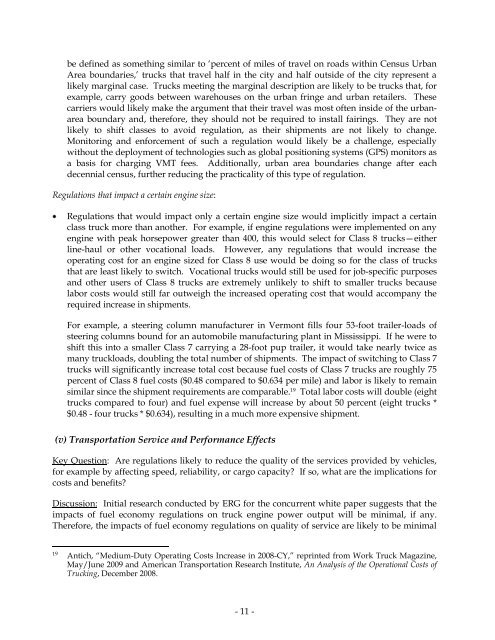Assessment of Fuel Economy Technologies for Medium and Heavy ...
Assessment of Fuel Economy Technologies for Medium and Heavy ...
Assessment of Fuel Economy Technologies for Medium and Heavy ...
You also want an ePaper? Increase the reach of your titles
YUMPU automatically turns print PDFs into web optimized ePapers that Google loves.
e defined as something similar to ‗percent <strong>of</strong> miles <strong>of</strong> travel on roads within Census Urban<br />
Area boundaries,‘ trucks that travel half in the city <strong>and</strong> half outside <strong>of</strong> the city represent a<br />
likely marginal case. Trucks meeting the marginal description are likely to be trucks that, <strong>for</strong><br />
example, carry goods between warehouses on the urban fringe <strong>and</strong> urban retailers. These<br />
carriers would likely make the argument that their travel was most <strong>of</strong>ten inside <strong>of</strong> the urbanarea<br />
boundary <strong>and</strong>, there<strong>for</strong>e, they should not be required to install fairings. They are not<br />
likely to shift classes to avoid regulation, as their shipments are not likely to change.<br />
Monitoring <strong>and</strong> en<strong>for</strong>cement <strong>of</strong> such a regulation would likely be a challenge, especially<br />
without the deployment <strong>of</strong> technologies such as global positioning systems (GPS) monitors as<br />
a basis <strong>for</strong> charging VMT fees. Additionally, urban area boundaries change after each<br />
decennial census, further reducing the practicality <strong>of</strong> this type <strong>of</strong> regulation.<br />
Regulations that impact a certain engine size:<br />
Regulations that would impact only a certain engine size would implicitly impact a certain<br />
class truck more than another. For example, if engine regulations were implemented on any<br />
engine with peak horsepower greater than 400, this would select <strong>for</strong> Class 8 trucks—either<br />
line-haul or other vocational loads. However, any regulations that would increase the<br />
operating cost <strong>for</strong> an engine sized <strong>for</strong> Class 8 use would be doing so <strong>for</strong> the class <strong>of</strong> trucks<br />
that are least likely to switch. Vocational trucks would still be used <strong>for</strong> job-specific purposes<br />
<strong>and</strong> other users <strong>of</strong> Class 8 trucks are extremely unlikely to shift to smaller trucks because<br />
labor costs would still far outweigh the increased operating cost that would accompany the<br />
required increase in shipments.<br />
For example, a steering column manufacturer in Vermont fills four 53-foot trailer-loads <strong>of</strong><br />
steering columns bound <strong>for</strong> an automobile manufacturing plant in Mississippi. If he were to<br />
shift this into a smaller Class 7 carrying a 28-foot pup trailer, it would take nearly twice as<br />
many truckloads, doubling the total number <strong>of</strong> shipments. The impact <strong>of</strong> switching to Class 7<br />
trucks will significantly increase total cost because fuel costs <strong>of</strong> Class 7 trucks are roughly 75<br />
percent <strong>of</strong> Class 8 fuel costs ($0.48 compared to $0.634 per mile) <strong>and</strong> labor is likely to remain<br />
similar since the shipment requirements are comparable. 19 Total labor costs will double (eight<br />
trucks compared to four) <strong>and</strong> fuel expense will increase by about 50 percent (eight trucks *<br />
$0.48 - four trucks * $0.634), resulting in a much more expensive shipment.<br />
(v) Transportation Service <strong>and</strong> Per<strong>for</strong>mance Effects<br />
Key Question: Are regulations likely to reduce the quality <strong>of</strong> the services provided by vehicles,<br />
<strong>for</strong> example by affecting speed, reliability, or cargo capacity If so, what are the implications <strong>for</strong><br />
costs <strong>and</strong> benefits<br />
Discussion: Initial research conducted by ERG <strong>for</strong> the concurrent white paper suggests that the<br />
impacts <strong>of</strong> fuel economy regulations on truck engine power output will be minimal, if any.<br />
There<strong>for</strong>e, the impacts <strong>of</strong> fuel economy regulations on quality <strong>of</strong> service are likely to be minimal<br />
19<br />
Antich, ―<strong>Medium</strong>-Duty Operating Costs Increase in 2008-CY,‖ reprinted from Work Truck Magazine,<br />
May/June 2009 <strong>and</strong> American Transportation Research Institute, An Analysis <strong>of</strong> the Operational Costs <strong>of</strong><br />
Trucking, December 2008.<br />
- 11 -
















